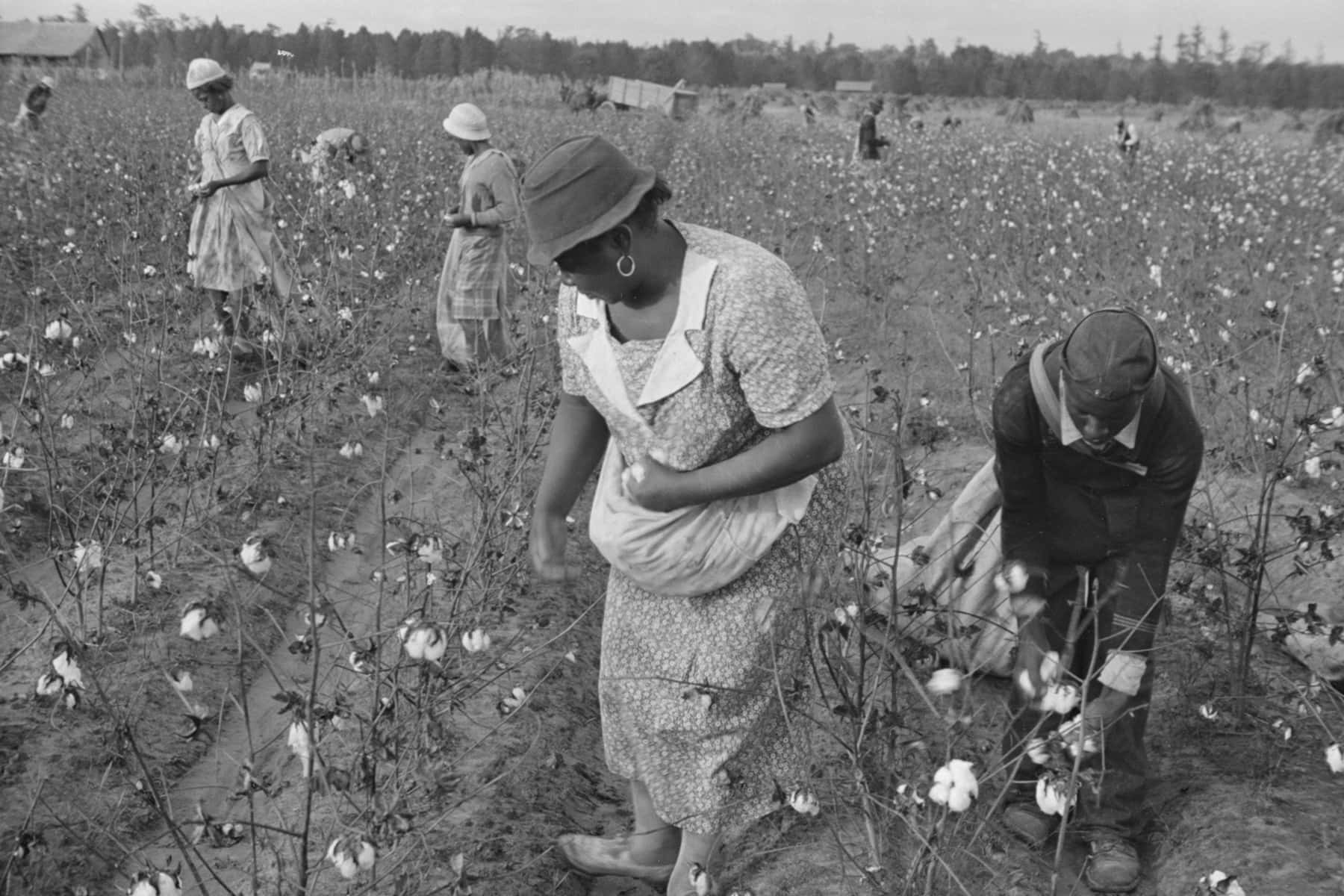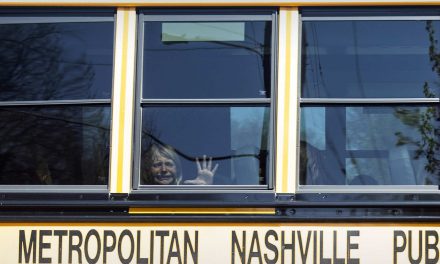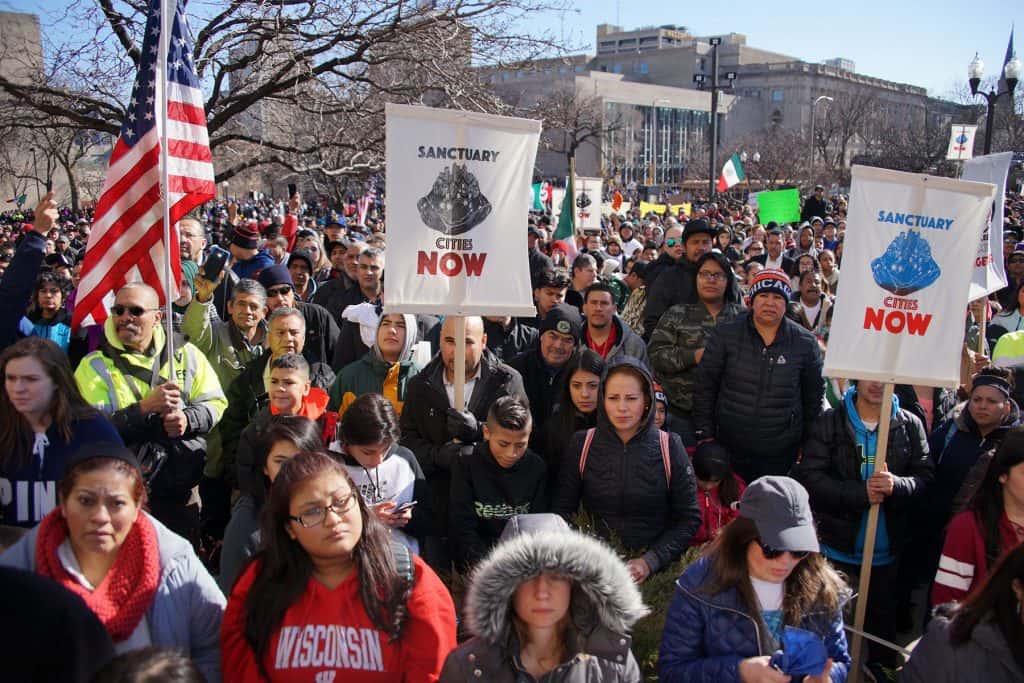
“The U.S. economy must undergo a fundamental change if it is to retain a measure of economic viability let alone leadership in the remaining 20 years of this century. The goal must be nothing less than the reindustrialization of America.” – Business Week, June 30, 1980
This warning about the U.S. economy from Business Week came nearly forty years after something monumental happened to Black workers in the Mississippi Delta and other parts of the South. On a hot October day in 1944 a mechanized cotton picker was put on display for the first time.
For a majority of their time in this country Black people have been the mules that plowed the fields, picked the cotton, cleared the land and made White plantation and farm owners wealthy beyond what they deserved. It reminds me of the commercial with the scrubbing bubbles saying “we work hard so you don’t have to.” Once cotton became king it never relinquished its’ throne in the South. In the exceptionally fertile lands on the Mississippi Delta, where my family was enslaved and resided in after formal slavery ended, sharecropping and convict leasing became the new slavery.
The definitive work on this system is Douglas A. Blackmon’s, Slavery By Another Name: The Re-Enslavement of Black Americans From the Civil War to World War II. He explains the convict lease system by showing how it was an extension of slavery in this country after the Civil War ended and slavery was supposedly abolished.
“Under laws enacted specifically to intimidate blacks, tens of thousands of African Americans were arbitrarily arrested, hit with outrageous fines, and charged for the costs of their own arrests. With no means to pay these ostensible “debts,” prisoners were sold as forced laborers to coal mines, lumber camps, brickyards, railroads, quarries, and farm plantations. Thousands of other African Americans were simply seized by southern landowners and compelled into years of involuntary servitude. Government officials leased falsely imprisoned blacks to small-town entrepreneurs, provincial farmers, and dozens of corporations—including U.S. Steel—looking for cheap and abundant labor. Armies of “free” black men labored without compensation, were repeatedly bought and sold, and were forced through beatings and physical torture to do the bidding of white masters for decades after the official abolition of American slavery.”
Sharecropping was a system where the landlord/planter allowed tenants to use the land in exchange for a share of the crop they planted and harvested. Throughout the South, black families rented land from white owners and raised cash crops such as cotton, tobacco, and rice. The land owners leased equipment to the sharecroppers, as well selling them seed, fertilizer, food, and other items on credit until the harvest came in. The sharecropper and landlord would settle up, figuring out who owed whom and how much. Due to financial shenanigans, high interest rates, unpredictable harvests, and unscrupulous landlords sharecropper families were often severely indebted by the end of the season. The debt would then be carried over until the next year or year after that. Laws made it illegal for sharecroppers to sell their crops to others besides their landlord, and also made it against the law to move off the land if they still owed a debt. Many White families were caught up in this system also.
Wealthy whites in the South lost the Civil War but but maintained their system of supremacy over the people they had enslaved for generations as well as many poor Whites. The Thirteenth Amendment is said to have ended slavery but it allowed slavery in a different form to flourish. The words of the Thirteenth Amendment “Neither slavery nor involuntary servitude, except as a punishment for crime whereof the party shall have been duly convicted, shall exist” were borrowed from other laws written many years before. Section 14, Article 6 of the 1787 Northwest Ordinance used nearly the same words. “There shall be neither slavery nor involuntary servitude in the said territory, otherwise than in the punishment of crimes whereof the party shall have been duly convicted.” Likewise some of the Northern states that abolished the institution of slavery before 1865 used the same language in the laws they wrote. That language allows the system of convict leasing to develop.
On October 2, 1944 on a farm in Clarksdale, Mississippi, farm owner Howard Hopson allowed his land to be used to demonstrate a mechanical cotton picker that could pick one thousand pounds of cotton in one hour. Blacks who had been a huge part of the labor force in the South since they first arrived in 1619 on a good day could pick about twenty pounds per person per hour. The mechanical picker could do the work of fifty people. For the first time in their lives, Black farm workers were no longer needed. It took five years before the mechanical cotton picker was used in a widespread manner. In 1949, 94 percent of all cotton in the South was still picked by hand. Fifteen years later just 15 percent was still picked by hand and none by 1972. Automation devastated the Black community because even though the jobs were not good paying jobs they provided wages and for those who were sharecropping it provided a place to stay on land owned by Whites. When the mechanical devices came these sharecroppers were no longer needed and were evicted in large numbers.
While millions of people lost jobs due to the economic impact of the ongoing pandemic, Blacks and other people of color have been on the front lines of layoffs. Over 30 million Americans were without employment due to the pandemic by the end of May.
Because Blacks are more likely to work in service sector jobs that don’t allow them to work in a safe place or at home, they have been impacted by layoffs more than Whites. According to data from the department of labor just 20 percent of Black workers have jobs that allow them to work from home while 30 percent of Whites have the ability to work from home. In addition to this, Blacks are much more likely to live in a home with just one wage earner which exacerbates the already difficult life circumstances they deal with.
Valerie Wilson at the Economic Policy Institute told Marketplace, “Given occupational segregation, African Americans are less likely to be in those higher-paid occupations. That in large part accounts for the disparity in the share of African American workers able to work remotely during this time. When you lose your job, all of the resources available to that household go. It’s unlikely anyone who loses a job now will be able to quickly find another one.”
Blacks were still trying to recover from the Great Recession when this pandemic hit. Speaking of the 2007-2009 recession economist Gary Hoover at the University of Oklahoma reported that “[White people] recovered faster, were able then to increase assets and savings, that in the current crisis will help them fare much better. [Black people] being in that precarious spot with much lower wealth are going to have a difficult time if this pandemic goes on much longer.”
According to a New York Times analysis, Black workers stand to be hurt the most if Congress can not reach compromise on extending the extra unemployment benefits. “Black workers disproportionately live in states with the lowest benefit levels and the highest barriers to receiving them according to the Times. “It’s just a pretty straightforward fact that one of the biggest problems facing unemployed Black workers is that they live in places with particularly inadequate unemployment insurance systems,” said Jared Bernstein, a senior fellow at the Center on Budget and Policy Priorities. “Among Black workers, almost one in four live in just three states: Florida, Georgia and Texas. And nearly 60 percent overall live in the South” states that traditionally have the lowest benefit levels as well as shortest periods of availability of unemployment benefits. A July study by economists from the University of California-Berkley, the University of Chicago and University of Illinois at Urbana-Champaign showed that Black workers laid off in April were the least likely group to be called back to work in May and June.
As mechanized cotton harvesters displaced millions of Black workers in the 1940’s through the 1960s Black people fled to cities outside the South to work in America’s factories. Milwaukee had over 130,000 factory jobs in the late 1940s. Because those jobs opened up to Blacks because of the WWII labor shortage, the Black population of the city grew exponentially from just 8,821 in 1940 to over 105,000 by 1970. By 2017 there were less than 28,000 manufacturing jobs left in Milwaukee. Over 92,000 were lost from 1963 until 2017, including 52,000 since 1982.
In 1970, 43 percent of Blacks who worked in the city were employed in a blue collar job. That was the highest rate for Blacks in the country. As a result of these good paying jobs, the median family income in Milwaukee was the seventh highest in the country for Black people. Economically things were going well for Black Milwaukee at that time.
That 1970 median family income is the equivalent of what would be nearly $50,000 in today’s money. Since those jobs largely left the city and abandoned Milwaukee’s famous blue collar workforce, the city has suffered mightily. No one has suffered from those jobs being replaced by low wage service sector jobs the way Blacks have. That median family income which was exceed by just six cities nationwide in 1970 is now just under $28,000, a drop of nearly fifty percent since 1970.
In 1970 the top employers in metro Milwaukee were: Allis Chalmers (11,500 employees); A.O. Smith (8,000 employees); Briggs & Stratton (7,400 employees); Allen Bradley (6,500 employees); AC Electronics (5,000 employees); Harnischfeger (4,450 employees); American Motors (4,000 employees); Schiltz Brewing (2,800 employees); Pabst Brewing (2,600 employees); and Miller Brewing (2,400 employees). Just four of those companies still exist in Milwaukee. Three of them are under different ownership and have significantly less workers than they did in 1970. Briggs & Stratton is in bankruptcy and had 510 factor jobs in 2017. Allen Bradley is now Rockwell Automation and had just 750 jobs in 2017. Harnischfeger is now Japanese owned Komatsu and had just 900 jobs in 2017. Miller Brewing is now MillerCoors, a subsidiary of Molson Coors and had just 630 plant jobs in 2016.
The impact of job losses in the city of Milwaukee for the Black and Latinx community is especially pronounced. Non-Hispanic Whites account for less than 36 percent of the people who live in Milwaukee but according to 2017 data from the Census Bureau they have 72.1 percent of the jobs in the city. Blacks are the largest group in the city making up nearly 39 percent of residents yet they only have 21.3 percent of the jobs in Milwaukee. Similarly Latinos are underrepresented in share of jobs, accounting for 18.4 percent of the population but have just 9.6 percent of all jobs in the city.
Looking at what happens each morning during the week prior to the COVID-19 pandemic hit exposes Whites who complain about Milwaukee, but then don’t have an issue coming into the city from the burbs to work. Each workday 65,900 Whites come to Milwaukee from the suburbs within Milwaukee County and the exurban counties of Waukesha, Ozaukee and Washington County to work in Milwaukee. At the same time 32,565 Blacks and 8,857 Latinos are moving in the opposite direction, going to the suburbs and exurbs to go to work. The fact that these suburban and exurban residents then take their hard earned paychecks back to the burbs to spend in those communities including the paying of property taxes there explains a lot about what is ailing Milwaukee today.
In 1982, Barry Bluestone and Bennett Harrison wrote the most detailed account of the loss of manufacturing jobs in the country at that time, The Deindustrialization of America: Plant Closings, Community Abandonment, and the Dismantling of Basic Industry. The authors start the book by telling the story of Polish factory workers in Detroit who were told by General Motors that the company would build a new factory and offer them jobs if they were willing to permit the company to tear down their neighborhood to build the new factory.
In Pittsburgh U.S. Steel announced in 1980 that they were permanently closing fourteen steel mills in eight states laying off over 13,000 workers as they received a $850 million tax break from the federal government which they used as a down payment to purchase Marathon Oil. In the 1960s the gross national product (GNP) grew by fifty percent but just 2.9 percent in the decade of the 1970’s. Exceptionally high inflation during that decade meant, “ the typical family with a $20,000 annual income had only 7 percent more purchasing power than it had a full decade earlier. Ten years had brought a mere $25 more per week in purchasing power to the average family…every bit of this growth came between 1970 and 1973.”
By the end of the 1970s for the first time in decades, the American standard of living was no longer the highest in the world, falling to tenth highest. “By 1980 Switzerland, Sweden, Denmark, West Germany, Luxembourg, Iceland, France, the Netherlands, and Belgium had all surpassed the United States in per capita GNP” according to the authors. The combined unemployment and inflation rates, what former President Jimmy Carter called the “misery index,” reached nearly 20 percent, three times higher than it was in the 1960s.
Bluestone and Harrison defined deindustrialization as “a widespread, systemic disinvestment in the nation’s basic productive capacity.” They blame this on resources being “diverted from productive investment in our basic national industries into unproductive speculation, merger and acquisitions, and foreign investment.”
This opened the door to shuttered factories, millions of displaced American workers, and ghost towns formerly inhabited by those living the American dream. Companies refused to invest in new equipment leaving the nation unable to compete with other nations. Instead of investing in the nation’s industries many otherwise profitable companies spent funds like U.S. Steel did, wasting billions to buy an oil company. General Electric extended its worldwide workforce by creating 30,000 foreign jobs and cutting U.S. jobs by 25,000. RCA Corporation cut U.S. jobs by 14,000 while adding 19,000 overseas jobs. Ford spent 40 percent of its capital budget outside of the U.S. and General Motors spent millions building new overseas plants.
The huge disinvestment that was taking place in the 1970s and early 1980s caused somewhere between 32 and 38 million American jobs to be lost in the 1970s. In New England for every new job created in new investments, two to four jobs was lost. In the aircraft industry in New England 3.6 jobs were lost for every new one that was created. It was not just the Rust Belt regions in the Northeast and Midwest that were hit hard. Almost half the jobs lost to plant closings and relocations during the decade of the 1970s occurred in the Sunbelt region in the South and West.
Some well known economists created a mythology blaming workers for the demise of these jobs. George Gilder’s book Wealth and Poverty which was reputedly on the bedside of President Ronald Reagan put it succinctly.
“The problem of contemporary capitalism lies not chiefly in a deterioration of physical capital, but in persistent subversion of psychological means of production — the morale and inspiration of economic man.”
This blaming the victim philosophy is one that I’ve heard many times when discussing the plight of the Black community in Milwaukee. Blacks who left the South to come to the city in large measure because of the abundance of good, family supporting wage jobs, supposedly got lazy and that’s why they are in the condition they are in today. Last time I checked, Blacks did not have ownership of any of those large employers I mentioned earlier.
Economists like Gilder basically say that Americans have lost the “commitment to innovation, entrepreneurship, and old-fashion hard work” according to Bluestone and Harrison. Another group of economist known as supply siders blamed the job losses on “big government.” David Stockman, Reagan’s director of the Office of Management and Budget was the most well known advocate of this theory. He blamed high corporate taxes, generous safety net “welfare” programs, and business regulation for supposedly disincentivizing hard work, saving and new product investment.
Reagan took advantage of these theories to push through massive corporate tax cuts, and deregulation of businesses. The leaders of these corporations instead of investing the savings from tax cuts began investing in bigger homes, luxury cars, helicopters and other luxurious goods. They took higher salaries, and built exorbitant “golden parachutes” to safely land when they left big companies.
Many blamed the Japanese for the loss of jobs in the auto industry. Japanese car companies like Toyota and Honda had the insight to build more gas efficient vehicles in the 1970s than their American counterparts as the OPEC oil crisis was causing gas shortages, quotas on gas purchases and miles-long lines to fill up your car throughout the country in the early 1970s. In 1960 Japanese automakers sold just 38,809 cars worldwide. By the 1970s they had twenty percent of car sales in the U.S. selling 2.3 million vehicles. Japanese companies sold more goods to Americans than Americans sold to Japanese citizens. By 1979 the Japanese economy was exporting $26 billion of goods here while American firms sent just $17.5 billion to Japan.
In a 1980 survey conducted and appearing in Productivity magazine, top managers at 221 firms “cited poor management, weak capital spending, and poor training programs as the major causes of depressed productivity—not workers themselves.” In fact in the 1970s American labor force participation rates increased from 60 to 64 percent. American workers were working harder and more hours for less pay and poorer benefits. Many of the countries listed above had notoriously high taxes and well-funded social safety net programs we derisively call welfare in this country. The economists who blamed those things for the problems here could not explain how those other countries surpassed the U.S. in GNP.
In the year right after WWII ended more Americans went out on strike than in any year in the nation’s history. The Wagner Act of 1935 gave workers in the private sector the right to organize unions and collectively bargain with management over wages and work rules. The act prohibited “unfair labor practices’ which had been commonplace including blacklisting of prospective employees. The 1938 Fair Labor Standards Act abolished child labor, established the first minimum wage in the country and established the eight hour work day. These laws helped boost union membership nationwide. Big business was not happy with these laws. They lobbied Congressmen to reverse these trends.
In 1947 Congress over-rode President Truman’s veto and passed the Taft-Hartley Act which immediately nullified portions of the Wagner Act. It made sympathy strikes and secondary boycotts something unions could be held liable for financially. The law also made labor contracts legally enforceable meaning companies could then sue unions for going on strike if a no-strike provision was in their contract.
The most important section of the Taft-Hartley Act, section 14(b) allowed individual states to override federal law and enact so-called “right-to-work” laws which made compulsory union membership illegal. Many unions were decertified beginning in the South. Congressmen from those states had pushed the hardest for the veto override. They made union dues paying voluntary which weakened the ability of unions to raise funds. By 1980 twenty states had these laws in place including every Southern state except Kentucky, West Virginia, Maryland and Delaware. Today twenty-seven states have those laws on the books including Wisconsin. Since 1980, Wisconsin, Michigan, Missouri, West Virginia, Kentucky, Oklahoma, and Idaho have passed “right-to-work” laws. Union membership which was a robust 33.4 percent in 1945 is today just 11.6 percent according to the Department of Labor. “The union membership rate of public-sector workers (33.6 percent) continued to be more than five times higher than the rate of private-sector workers (6.2 percent)…The highest unionization rates were among workers in protective service occupations (33.8 percent) and in education, training, and library occupations (33.1 percent).”
Nonunion workers had median weekly earnings that were 81 percent of earnings for workers who were union members ($892 versus $1,095). Black workers (11.2%) are more likely today to be union members than Whites (10.3%), Hispanics (8.9%) and Asians (8.8%). Overall 7.1 million employees in the public sector belong to a union, compared with 7.5 million workers in the private sector.
In Wisconsin just 8.1 percent of workers were in unions in 2019. Hawaii (23.5%) and New York (21%) are both over twenty percent, while our neighbors Minnesota (13.7%) and Illinois (13.6%) are both significantly higher than Wisconsin. In 2004 the rate of 16.1 percent in Wisconsin was nearly double what it is today. In 2011, Wisconsin passed Act 10 that all but eliminated the union rights of most public employees. Firefighters and police officers were the only exceptions to the law. The year prior to Act 10’s passage the union membership rate in the state was 14.3 percent. In 1964, 34.9 percent of Wisconsin workers were in unions and 44.8 percent of those in Michigan were. In my lifetime, the rate in Wisconsin has dropped by 76.7 percent and in Michigan where my father lives, it has dropped by 69.6 percent.
Looking at 1980 again shows a profound shift for American workers. Worker wages started to flatten out and, worker productivity and CEO salaries rose dramatically beginning that year according to Les Leopold’s Runaway Inequality: An Activist’s Guide to Economic Justice. Consumer debt, student loan debt, government debt, the prison population, homelessness and child poverty all started to rise around the same time. In 1982 globalization, automation, increased overseas competition, the growth of service sector jobs and weakening of unions combined with President Reagan’s firing of 11,000 striking air traffic controllers created a perfect storm.
An economy that from WWII until the 1960s was the envy of the world, America fell on hard times. Military spending on Vietnam and the Cold War, the oil embargoes of 1973 and 1979, strengthening economies in Japan and Europe, and social turmoil in the 1960s all combined to undo the economic growth.
The federal government began to shift spending in the late sixties to law enforcement by passage of the 1965 Law Enforcement Assistance Act which established “a direct role for the federal government in local police operations, court systems and state prisons for the first time in American history” according to From the War on Poverty to the War on Crime by Elizabeth Hinton. The federal government defunded social service programs and abandoned the War on Poverty to fight a War on Crime under President Johnson. This continued under every administration through 2008.
Johnson’s War on Crime became the War on Drugs under Nixon and Reagan and the number of people employed by the criminal justice system grew from 729,161 in 1969 to 2,270,140 in 2013. On the local level it increased from (513,337 to 1,377,588) On the state level it grew from (160,339 to 732,213) and at the federal level from (55,485 to 160,339). While on any given day 2.2 million Americans are incarcerated in prisons and jails, 2.3 million people are employees of the criminal justice system. The current calls for defunding the police are simply requests to reverse the policies of the past 50 years when we went from a War on Poverty to a War on Crime and once again fund a war against poverty.
Prior to 1980 the basic philosophy of corporate America was “retain and reinvest.” “Corporate survival and prosperity depended on plowing back most of a corporation’s profits into increased worker wages and training, research and development, and new plant and equipment” according to Leopold. When deregulation occurred under Reagan, Wall Street went rogue. “A new breed of financiers appeared to buy up companies. Instead of creating new value within the corporation, these corporate raiders (today called private equity and hedge fund managers) wanted to extract value out and away from the corporation and into their pockets.” This deregulation began the trend of mergers and acquisitions I mentioned earlier.
Most Americans have forgotten the devastating recession which occurred from July 1981 to November 1982. According to an article at the Federal Reserve by Tom Sablik,
“Prior to the 2007-09 recession, the 1981-82 recession was the worst economic downturn in the United States since the Great Depression. Indeed, the nearly 11 percent unemployment rate reached late in 1982 remains the apex of the post-World War II era. Unemployment during the 1981-82 recession was widespread, but manufacturing, construction, and the auto industries were particularly affected. Although goods producers accounted for only 30 percent of total employment at the time, they suffered 90 percent of job losses in 1982. Three-fourths of all job losses in the goods-producing sector were in manufacturing, and the residential construction industry and auto manufacturers ended the year with 22 percent and 24 percent unemployment, respectively.”
The 9.6 percent unemployment rate among Whites in November 1982 was nothing compared to the Black unemployment rate at the beginning of the recession. In July 1981 the national unemployment rate for Blacks was already 15 percent. By the time the recession ended it was at 20.2 percent but kept rising, reaching 21.2 percent in January 1983. It was still 11.5 percent five and a half years later in June 1988. The massive unemployment rates played a major role in the influx of drugs and led many who could not find work to sell drugs in the 1980s.
For Black teenagers it was particularly difficult to find work in the early 1980s. At the beginning of the recession in November 1981, 16-19 year-old Blacks had an unemployment rate of 39 percent. Their White peers had a rate of 19 percent. In June 1982 the Black rate peaked during the recession at 52 percent, while the White peak during the recession was 21.3 percent in November 1982 when the recession ended. In August 1983 months after the recession had ended the Black rate was 52.1 percent and their White peers were at 19.7 percent.
The federal minimum wage has been stuck at $7.25 per hour for eleven years. Student loan debt is now in excess of $1.56 trillion. That’s trillion with a “T.” Consumer debt is currently $14.3 trillion. The national debt is now $26.6 trillion. The nation is in a very precarious position.
Many Americans have forgotten the impact of the Great Recession which devastated the U.S. economy from December 2007 to June 2009. It was the largest recession since the Great Depression surpassing the 1981-1982 recession. According to the Federal Reserve it was “the longest recession since World War II…The unemployment rate, which was 5 percent in December 2007, rose to 9.5 percent in June 2009, and peaked at 10 percent in October 2009… The recession ended in June 2009, but economic weakness persisted.”
“One in five employees lost their jobs at the beginning of the Great Recession. Many of those people never recovered; they never got real work again.” – Peter Cappelli
When the Great Recession began the Black unemployment rate was already 9 percent and 32.8 percent for 16-19 year-old Blacks. For Whites the rates were 4.4 percent and 14.4 percent respectively. The Black unemployment rate peaked at 15 percent a month before the recession ended, for 16-19 year-old Blacks it peaked at 39.1 percent the month the recession ended. It continued to grow reaching 16.6 percent in April 2010 for Blacks overall and was 48.9 percent in September 2010 for 16-19 year-old Blacks showing that the recession had not ended for them. For their White peers unemployment peaked during the recession at 8.7 percent and 16-19 year-old Whites saw their highest rate of 21.9 percent at the end of the recession.
Americans’ belief in the strength of the economy prior to the current pandemic is built on a myth. According to the U.S. Census Bureau “After adjusting for inflation…today’s average hourly wage has just about the same purchasing power it did in 1978, following a long slide in the 1980s and early 1990s and bumpy, inconsistent growth since then. In fact, in real terms average hourly earnings peaked more than 45 years ago: The $4.03-an-hour rate recorded in January 1973 had the same purchasing power that $23.68 would today.” Americans are more productive than they’ve ever been but are not properly compensated for this hard work. Instead the profits of that increased productivity has gone to the owners of the companies we work for.
“For every dollar the average worker made, a CEO in 1970 made $45. By 2014 for every dollar earned by the average worker, CEO’s made a whopping $844.” – Les Leopold
Wage inequality has grown between the top earners and the bottom earners. “In 2016 Americans in the top tenth of the income distribution earned 8.7 times as much as Americans in the bottom tenth ($109,578 versus $12,523). In 1970, the top tenth earned 6.9 times as much as the bottom tenth ($63,512 versus $9,212).”
COVID 19 has exacerbated the economic divide. According to a Pew Research survey in early May, “three-quarters of Black (73%) and Hispanic adults (70%) said they did not have emergency funds to cover three months of expenses; around half of White adults (47%) said the same. The vast majority of Black and Hispanic adults without financial reserves also said they would not be able to cover their expenses for three months by borrowing money, using savings or selling assets.”
Black people can attest to the fact that bad times are always worse for us. Just as the roaring twenties were not roaring for Black people, the Great Depression, Great Recession and the current recession have been and continues to be much worse for our community.
“I’m just another Black man caught up in the mix
Trying to make a dollar out of fifteen cents (A dime and a nickel)”
– Tupac Shakur 1993














